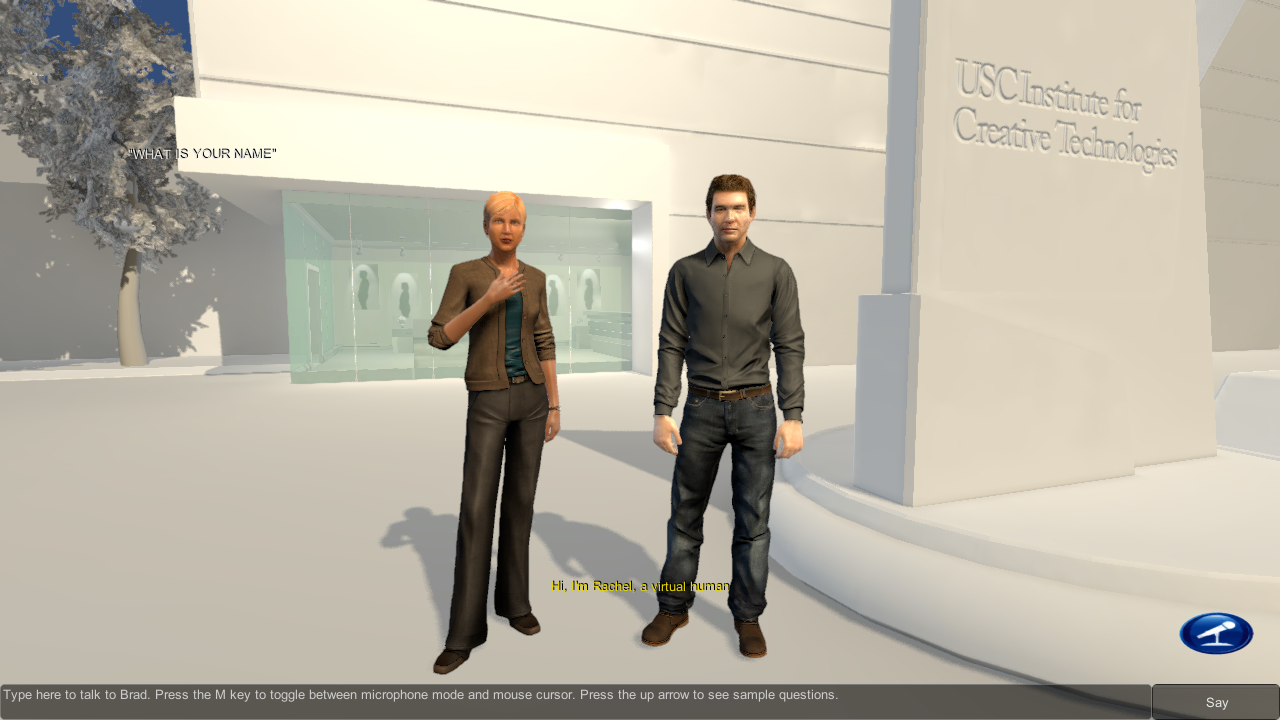Loading the Scenario
- If you checked the 'Run Virtual Human Toolkit Launcher' option at the end of the installation, the Launcher will begin automatically. Otherwise, for Windows, use 'run-launcher.bat' in your installation folder ("c:\vhtoolkit" by default), or for Mac OS, use VHToolkitLauncher in Applications.
- The Launcher allows users to launch and quit entire scenarios or a subset of the needed components. See the Launcher documentation for more details.
- In order to launch all components needed for the example scenario, click the button with the green up arrow icon in the Run Checked row, under the Run It All section.
- A variety of modules start minimized, after which Unity comes up full-screen. This can take a few moments.
- When all modules are fully loaded, Brad and Rachel will introduce themselves. After this, a window will pop up with tips; you can read these or close the window.
Notes
- Before launching the scenario, you can change some of the default settings, like resolution and whether to play the intro. Click 'Advanced' on the Launcher and change the parameters in the 'Renderer' row.
- If you are not seeing the expected results, click 'Advanced' in the Launcher and see if all the checked rows are green. If all of them are orange, make sure ActiveMQ is running. For windows, right-click on Computer in the start menu, select Manage, expand Services and Applications, click on Services and see if the ActiveMQ service is running. If it is listed and not running, select it and click the Play icon above or right click and select Start. If it is not listed, use the Toolkit installer with 3rd party software and make sure the ActiveMQ box is selected. If some Launcher rows are green and others are orange, try launching the orange ones manually and note any errors. You can bring up the Launcher command line with 'CTRL + T'.
- If you run into any other problems, please see the FAQ for possible solutions or use the available Support channels.
- Use the 'J' key to toggle mouse look, and the 'W', 'A', 'S' and 'D' keys to move the camera. For more keyboard controls in Unity, see vhtoolkitUnity.
- In Windows, you can exit from Unity's full screen mode to window mode by using ALT + Enter. In Mac OS use Command + Esc. Alternatively, you can bring up the console (~ key in Windows, ` key in Mac OS) and type in 'toggle_fullscreen', without the quotes)
Mac OS Known Issues
Note that Windows is the main development platform for the Toolkit and as such the Mac OS version may have some quirks. In general, make sure you have the latest Java 1.6 and latest Mono installed. The Toolkit has only been tested on 10.8 and 10.9.
Some of the known issues are:
- Unity only loads full-screen, regardless of Launcher parameter. Work-around: when in Unity, use Command + Esc. Alternatively, the ` key (top left on the keyboard) to bring up the console, and type in 'toggle_fullscreen', without the quotes.
- Character's response is very slow; this is due to slow parsing of the response by the NVBG / Charniak parser.
- Characters don't gesture.
- TTS is not yet implemented.
- Rachel's hand clips through her leg after her first response.
- Performance may be slow on older or lower end machines, like the Mac Mini.
